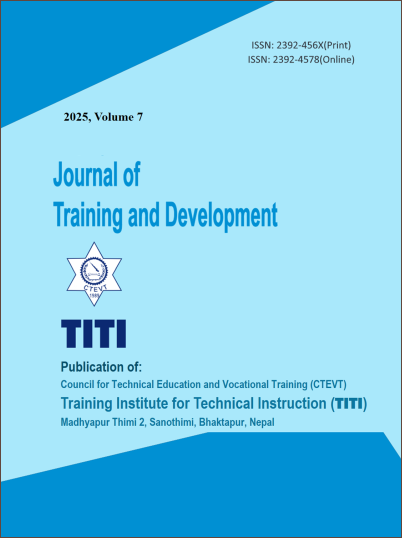Challenges and Opportunities for Industry-School Partnerships in Implementing Apprenticeships: A Case Study of Lumbini Province, Nepal
DOI:
https://doi.org/10.3126/jtd.v7i1.74973Keywords:
TVET, Apprenticeship, Industry-School PartnershipAbstract
Apprenticeship programs serve as an effective approach to integrating technical education and industry needs, offering tangible benefits for students, employers, and educational institutions. This study explores the challenges and opportunities for industry-school partnerships in establishing and implementing apprenticeship programs in Nepal, focusing on Lumbini Province. The study employs a qualitative, exploratory case study approach, with interviews and focus group discussions involving 30 stakeholders. It assesses challenges, such as limited industry participation, inadequate legislative frameworks, reliance on foreign labor, and weak collaboration between government and industry. Key findings underscore the necessity of raising industry awareness, fostering government-industry partnerships, and establishing clear policies to institutionalize apprenticeship systems. The article identifies opportunities for strengthening partnerships through improved communication, collaboration in curriculum development, and a focus on addressing industry needs along with some existing challenges.
Downloads
Downloads
Published
How to Cite
Issue
Section
License

This work is licensed under a Creative Commons Attribution 4.0 International License.
Authors who publish with this journal agree to the following terms:
- Authors retain copyright and grant the journal right of first publication with the work simultaneously licensed under a Creative Commons Attribution License that allows others to share the work with an acknowledgement of the work's authorship and initial publication in this journal.
- Authors are able to enter into separate, additional contractual arrangements for the non-exclusive distribution of the journal's published version of the work (e.g., post it to an institutional repository or publish it in a book), with an acknowledgement of its initial publication in this journal.
- Authors are permitted and encouraged to post their work online (e.g., in institutional repositories or on their website) prior to and during the submission process, as it can lead to productive exchanges, as well as earlier and greater citation of published work (See The Effect of Open Access).




